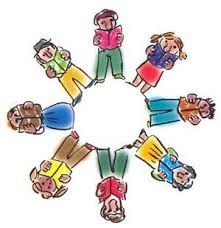![]()
![]()
![]()
Use LEFT and RIGHT arrow keys to navigate between flashcards;
Use UP and DOWN arrow keys to flip the card;
H to show hint;
A reads text to speech;
18 Cards in this Set
- Front
- Back

Literature Circles |
Small groups of children get together in a book club to read a story or book. Teachers select several books at the children's reading levels. The group selects the book they are most interested in reading together. The students establish a reading schedule and select roles.
Student Roles: http://madamekwiatkowski.weebly.com/uploads/2/2/7/1/22716436/4866053_orig.png |
|

Fluent Readers and Writers |
*read fluently and with expression *use decoding and comprehension strategies *write well-developed paragraphs *spell most high-frequency words correctly |
|

Marie Clay |
She changed the way teachers view readers by identifying the strategies effective readers use when reading.
Concepts About Print Reading Recovery: http://readingrecovery.org/reading-recovery/teaching-children/marie-clay |
|
|
Phonological System |
The sound system with 44 sounds and more than 500 ways to spell them.
Applications: decoding words, using invented spelling, noticing rhyming words, and dividing words into syllables. |
|
|
Principal #5: Effective Teachers Scaffold Childrens Reading and Writing. |
structure or grammar of a sentence |
|
|
Principal #5: Effective Teachers Scaffold Childrens Reading and Writing GUIDED READING AND WRITING
|
Reading: Teachers teach guided reading lessons to small homogenous groups using instructional level books. Writing: Teachers teach lessons on writing strategies, skills, and procedures, and children participate in supervised practice activities. |
|
|
Principal #5: Effective Teachers Scaffold Children's Reading and Writing INDEPENDENT READING AND WRITING |
Reading: Children read self selected books |
|
|
PreK through fourth grade balanced literacy instructional programs include these components: |
1. Reading 2. Phonemic Awareness and Phonics 3. Literacy strategies and skills 4. Vocabulary 5. Comprehension 6. Literature 7. Content |
|
|
Louise Rosenblatt |
-Explicit Instruction -Oral Language -Small-Group Work -Reading Aloud to Children -Background Knowledge -Authentic Literacy Activities
|
|
|
Reading and Writing Workshop |
Knowledge about phoneme-grapheme correspondences and rules. |
|
|
Principle 5: Modeled
|
Teachers demonstrate the procedures that they use to write and read for their students. |
|
|
Response to Intervention |
Tier 1: Screening and Prevention Tier 2: Early Intervention Tier 3: Intensive Intervention |
|
|
Zone of Proximal Development |
The Distance Between a child's actual developmental level and his/her potential level that can be reached with teacher scaffolding. (Vygotsky) |
|
|
Differentiate Instruction |
-Content -Process -Products
(3rd edition see pg. 23, 4th edition see pg. 25) |
|
|
Reading Recovery |
First-grade intervention program for lowest achievers. 30-minute daily one-on-one tutoring session taught by specifically trained and supervised teachers. |
|
|
Rubric |
A guide listing specific criteria for evaluating children's work; it includes levels of achievement and is scored numerically. |
|
|
Running Record |
A tool that helps teachers to identify patterns in student reading behaviors. These patterns allow a teacher to see the strategies a student uses to make meaning of individual words and texts as a whole. |
|
|
Instruction-Assessment Cycle |
1. Planning- Use knowledge about children's reading levels, background knowledge, and competencies to plan appropriate instruction. 2. Monitoring- Monitor the student's progress and check work. Reteach when necessary. 3. Evaluating- Assess using rubrics, checklists, and work samples. 4. Reflecting- Judge effectiveness of instruction by analyzing test results and adapt instruction accordingly. |

